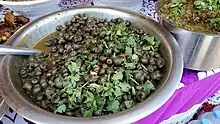 Ghonghi, fresh water snails popularly made in Tharu community | |
| Region or state | Terai region of Nepal |
|---|---|
| Associated cuisine | Nepalese cuisine (Tharu cuisine) |
| Serving temperature | Hot |
| Main ingredients | Freshwater snail and Flaxseed |
Ghonghi (Nepali: घोंगी) is a Nepalese fresh water snail dish prepared by the Tharu people of southern Nepal.[1]It is eaten by sucking the snail from its shell and is found throughout the Terai region where the Tharu people reside. It is also popular among Rajbanshi, Dhimals, Darai, Santhal and Danuwar people of Terai.[2]
Ghonghi is eaten during the paddy season, when rice is planted and there is abundant amount of snails present in the rivers and paddy fields. The collected snails are then cleaned, and the tails are cut to make it easier to extract the meat when cooked. The snails are then boiled and cooked similarly like other curries, with a crucial addition of flaxseed which not only gives the dish a consistency but also enhances its flavor.[3] Ghongis are served with rice and have been a staple food of the indigenous people of Terai for ages.[4][5]
It is believed that the meat provided the indigenous Tharu people the immunity to fight against malaria, a prevalent threat in the densely forested areas of Terai.[6]
See also
References
- ↑ Adhikari, Ashok (2016-03-16). "Ghonghi". nepal agriculture. Retrieved 2023-12-21.
- ↑ "Ghonghi, delicacy of snail – Boss Nepal". Retrieved 2023-12-21.
- ↑ "Tharu Tradition: Ghonghi Recipe - The Buzz Nepal". thebuzznepal.com. 2023-12-01. Retrieved 2023-12-21.
- ↑ "Tharu Cuisines and Delicacies (in Pictures)". The Nepali Food Blog | theGundruk.com. 2016-01-16. Retrieved 2023-12-21.
- ↑ Century-Foods (2022-09-21). "Traditional Nepali Must Try Dishes - A Highlight On Tharu Cuisine". Century Spices & Snacks. Retrieved 2023-12-21.
- ↑ "Tharu Cuisine Unveiled A Flavorful Journey". Hopnepal.com. Retrieved 2023-12-21.